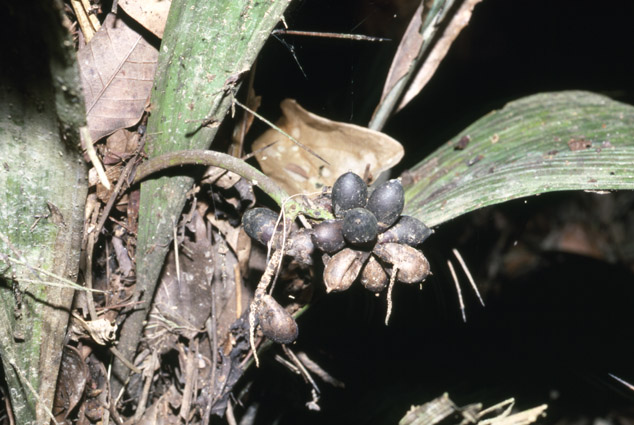- Acanthophoenix
- Acrocomia
- Actinokentia
- Actinorhytis
- Adonidia
- Aiphanes
- Allagoptera
- Ammandra
- Aphandra
- Archontophoenix
- Areca
- Arenga
- Asterogyne
- Astrocaryum
- Attalea
- Balaka
- Barcella
- Basselinia
- Beccariophoenix
- Bismarckia
- Borassodendron
- Borassus
- Brassiophoenix
- Burretiokentia
- Butia
- Calamus
- Calyptrocalyx
- Calyptrogyne
- Calyptronoma
- Carpentaria
- Carpoxylon
- Caryota
- Ceratolobus
- Ceroxylon
- Chamaedorea
- Chamaerops
- Chambeyronia
- Chelyocarpus
- Chuniophoenix
- Clinosperma
- Coccothrinax
- Cocos
- Corypha
- Cryosophila
- Cyphokentia
- Cyphophoenix
- Cyphosperma
- Daemonorops
- Deckenia
- Desmoncus
- Dictyocaryum
- Drymophloeus
- Dypsis
- Elaeis
- Eleiodoxa
- Eremospatha
- Eugeissona
- Euterpe
- Gaussia
- Geonoma
- Guihaia
- Hedyscepe
- Hemithrinax
- Howea
- Hyophorbe
- Hyospathe
- Hyphaene
- Iriartea
- Iriartella
- Itaya
- Jailoloa
- Johannesteijsmannia
- Juania
- Jubaea
- Jubaeopsis
- Kentiopsis
- Kerriodoxa
- Korthalsia
- Laccospadix
- Laccosperma
- Lanonia
- Latania
- Lemurophoenix
- Leopoldinia
- Lepidocaryum
- Lepidorrhachis
- Leucothrinax
- Licuala
- Linospadix
- Livistona
- Lodoicea
- Lytocaryum
- Manicaria
- Manjekia
- Marojejya
- Masoala
- Mauritia
- Mauritiella
- Maxburretia
- Medemia
- Metroxylon
- Myrialepis
- Nannorrhops
- Nenga
- Neonicholsonia
- Neoveitchia
- Nephrosperma
- Normanbya
- Nypa
- Oenocarpus
- Oncocalamus
- Oncosperma
- Orania
- Oraniopsis
- Parajubaea
- Pelagodoxa
- Phoenicophorium
- Phoenix
- Pholidocarpus
- Pholidostachys
- Physokentia
- Phytelephas
- Pigafetta
- Pinanga
- Plectocomia
- Plectocomiopsis
- Podococcus
- Pogonotium
- Ponapea
- Prestoea
- Pseudophoenix
- Ptychococcus
- Ptychosperma
- Raphia
- Ravenea
- Reinhardtia
- Retispatha
- Rhapidophyllum
- Rhapis
- Rhopalostylis
- Roscheria
- Roystonea
- Sabal
- Sabinaria
- Salacca
- Saribus
- Satakentia
- Satranala
- Schippia
- Sclerosperma
- Socratea
- Solfia
- Sommieria
- Syagrus
- Synechanthus
- Tahina
- Tectiphiala
- Thrinax
- Trachycarpus
- Trithrinax
- Veitchia
- Verschaffeltia
- Voanioala
- Wallaceodoxa
- Wallichia
- Welfia
- Wendlandiella
- Wettinia
- Wodyetia
- Zombia
- x Jubautia splendens
- ?? Acoelorrhaphe
- ?? Bentinckia
- ?? Brahea
- ?? Clinostigma
- ?? Colpothrinax
- ?? Copernicia
- ?? Cyrtostachys
- ?? Dictyosperma
- ?? Dransfieldia
- ?? Heterospathe
- ?? Hydriastele
- ?? Iguanura
- ?? Incertae sedis & excluded names
- ?? Loxococcus
- ?? Micronoma
- ?? Paripon
- ?? Pritchardia
- ?? Rhopaloblaste
- ?? Serenoa
- ?? Washingtonia

Distribution
Mostly south of the Amazon river in Colombia (Amazonas), Peru (Huanuco, Loreto, San Martin, Ucayali), and western Brazil (Acre, Amazonas); lowland rain forest either on terra firme or more commonly in areas liable to seasonal inundation or other wet places, at 106-600 m elevation (Henderson, A.J., Bactris (Palmae) in Flora Neotropica Monographs 79. 2000)A
Discussion
- Bactris bifida is diagnosed by its long, narrow, simple, strongly plicate leaves, deeply bifid apically and cuneate basally, staminodial ring, and ellipsoid, purple-black fruits. Synonymy was established by Henderson (1995), although he (and Henderson et aI., 1995) included B. angustifolia as a synonym of B. tomentosa var. sphaerocarpa, it properly belongs here.
There is considerable variation in the size of the leaves; specimens from the Andean foothills of Peru have much larger leaves than usual (Henderson, A.J., Bactris (Palmae) in Flora Neotropica Monographs 79. 2000)A
Common Name
- Brazil: ubim de espinho. Peru: ñeja negra (Henderson, A.J., Bactris (Palmae) in Flora Neotropica Monographs 79. 2000)A
Description
- Stems cespitose, forming small or large clumps, often leaning, 1-4 m tall, 1-2 cm diam., the internodes usually not spiny.
Leaves 4-10; leaf spines solitary and scattered, brown or black, to 8 cm long, on lateral surfaces of sheath, petiole, and rachis; sheath 12-28 cm long, very fibrous on margins; ocrea to 10 cm long, becoming fibrous; petiole (0-)12-22(-100) cm long; rachis 40-70 cm long; blade simple or rarely pinnate proximally, long cuneate basally, deeply bifid apically, strongly plicate, with a metallic sheen on drying; blade 40-100 cm long, 12-20 cm wide at apex of rachis.
Inflorescences interfoliar; peduncle 15-25 cm long, straight or slightly recurved, not spiny; prophyll 8-13 cm long; peduncular bract 16-25 cm long, sparsely covered with black spines to 5 mm long; rachillae 1-2,4-6.5 cm long, at anthesis glabrous or with a few flexuous trichomes; triads regularly arranged, these interspersed with paired or solitary staminate flowers; staminate flowers 3-6 mm long, deciduous; sepal lobes 1-1.5 mm long; petals 3-5.5 mm long; stamens 6; pistillode absent; pistillate flowers 3-4 mm long; calyx tubular, 3-4 mm long; corolla tubular, 2.5-3.5 mm long; staminodial ring obscure, 0.5 mm long; fruits 2-2.5 x 1-1.5 cm, narrowly ellipsoid, ovoid, or ellipsoid-oblong, purple-black, sometimes minutely spinulose; mesocarp juicy; endocarp ellipsoid, the sterile pores displaced longitudinally, the fertile pore displaced latitudinally; endocarp fibers free, numerous, with juice sacs attached; fruiting perianth with short calyx and much longer, crenate corolla, staminodial ring present. (Henderson, A.J., Bactris (Palmae) in Flora Neotropica Monographs 79. 2000)A
Use Record
- Bactris bifida Mart.: Bactris bifida is one of at least seven wild species in the genus with edible fruits that grow in the Pacaya-Samiria National Reserve. (Smith, N., R. Vásquez, and W. H. Wust 2007: Amazon river fruits. Flavors for Conservation)
Use Category Use Sub Category Plant Part Human Group Ethnic Group Country Human Food Beverages Fruits Not identified N/A Peru Human Food Beverages Fruits Not identified N/A Peru - Bactris bifida Mart.: Bactris bifida Mart. Español: Nejilla, Neja negra Usos: Alimenticio — Los frutos maduros son comestibles. Comunidad: 1, 3, 4, 6, 7, 9, 12–16, 18–21, 23–27. Voucher: H. Balslev 6604. (Balslev, H., C. Grandez, et al. 2008: Useful palms (Arecaceae) near Iquitos, Peruvian Amazon)
- Log in to post comments

